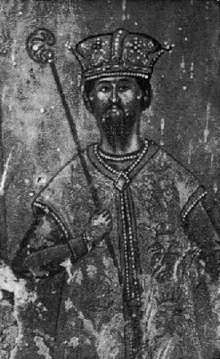Karl Thopia

Karl Thopia (* around 1335/40; † end of January 1388 ) was an Albanian prince.
Life
His parents were Andreas Thopia and Fiametta, a daughter of Robert of Anjou , King of Naples , who were killed in Naples in 1359 on the king's occasion. After the early death of their parents, the brothers Karl and Georg grew up in the fortress of Kruja and vowed to avenge their parents and, since they had Angevin blood in their veins, to assert their Angevin rights.
Karl ruled over large parts of Central Albania from 1359 to 1388 and called himself Princeps Albaniae . In 1361 Charles rose against the Angevin rule of Johanna von Durazzo , who lived primarily in Naples and did not care about her Duchy of Durazzo. Charles besieged Durazzo, which was ruled by a captain on behalf of Johanna von Durazzo. The republics of Venice and Ragusa , which had merchant colonies in the city, and Georg Balšić , son of Balša I , were also involved in the dispute. A plague decimated besiegers and besieged. The Angevin captain finally had to surrender in 1363 and Karl Topia became lord of Durazzo. From then on, he made the important port city the residence of his Principality of Albania .
Charles mostly maintained good relations with the Roman Curia . Therefore, the Archdiocese of Durrës , which had become vacant in 1376 , could be occupied again with a Latin bishop. In 1381 Karl founded the monastery of St. Johannes (alb. Shën Gjon ) near Elbasan .
His toughest competitors for power in Albania were the Balšići . In 1382 Balša II started the war and attacked Durrës . In 1385 Charles, who had called in Turkish troops, was able to decisively defeat his adversary in the Battle of Savra in the Myzeqe ; Balša was killed in the process.
In the last decade of his rule, Charles leaned closely on the Republic of Venice in terms of foreign policy . On August 17, 1386, the Republic and the Albanian prince concluded a formal alliance. Karl undertook to take part in all wars in the republic or to pay aid and deliver grain. He also promised the Venetian merchants protection in his land. In return, the republic provided him with a galley , allowed him to recruit mercenaries in their territories and instructed the captain of their Adriatic fleet to protect Karl's coasts from the Ottomans . They had carried out several heavy attacks on Durrës since 1386, which continued even when Karl died in January 1388. He was followed by his son Georg (alb. Gjergj ) in the rule.
family
Karl Thopia married (after 1363) Voisava Balšić , a daughter of the powerful dynast Balša I (Prince of Zeta ) and had three children with her:
- Georg , Karl's successor
- Karl
- Elena († after 1402) ⚭ 1. Marco, son of Marino Barbarigo ; ⚭ 2. Konstantin Kastrioti († 1402 beheaded in Durrës; son of Pal Kastrioti )
- Voisava ⚭ Isaak (Kyrsak)
literature
- Johann Samuelersch, Johann Gottfried Gruber (ed.): General encyclopedia of the sciences and arts . Leipzig 1868. 1st section, Part 86, p. 41 f. ( Digitized version )
- Peter Bartl: Thopia, Karl , in: Biographisches Lexikon zur Geschichte Südosteuropas . Volume 4. Munich 1981, p. 311 f.
Individual evidence
- ^ Ateneo Veneto: revista di scienze, lettere ed arti . A. Pellizzato, Venice 1908, p. 20 (Italian, archive.org ).
- ↑ Johann Georg von Hahn: Journey through the areas of the Drin un Wardar . Imperial and Royal Court and State Printing Office, Vienna 1867, p. 296 ( online version in Google Book Search).
- ↑ Revista bimestrale di Scienze, Lettere ed Arti, p. 7
- ^ Arturo Galanti: L'Albania: notizie geografiche, ethnografiche e storiche . Societa editrice Dante Alighieri, Rome 1901, p. 121 (Italian). , accessed November 8, 2016
- ↑ Miranda Vickers: Shqiptarët - Një histori modern . Bota Shqiptare, 2008, ISBN 978-99956-11-68-2 , Mbërritja e osmanëve, p. 18 (English: The Albanians - A Modern History . Translated by Xhevdet Shehu).
- ↑ a b L'Albania: notizie geografiche, ethnografiche e storiche, p. 122
- ↑ General Encyclopedia of Sciences and Arts, 1868, p. 41
- ↑ Johann Georg von Hahn: Journey through the areas of the Drin un Wardar . Imperial and Royal Court and State Printing Office, Vienna 1867, p. 295 ( online version in Google Book Search).
- ↑ Revista bimestrale di Scienze, Lettere ed Arti, p. 26
- ↑ a b General Encyclopedia of Sciences and Arts, 1868, p. 93
- ^ Medieval lineage of the Kastrioti. castriotascanderbeg.it, accessed April 2, 2018 (Italian).
| personal data | |
|---|---|
| SURNAME | Karl Thopia |
| BRIEF DESCRIPTION | Albanian prince |
| DATE OF BIRTH | around 1340 |
| DATE OF DEATH | January 1388 |
